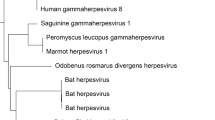Summary
We have investigated the pathogenicity of a US3 protein kinase-deficient mutant (L1 BR1) of herpes simplex virus type 2 (HSV-2) for 4-week-old ICR mice to define the role of the viral protein kinase in virus-host interaction. When mice were intraperitoneally infected with 105 PFU of L1 BR1, the virus disappeared from the peritoneal cavity by 2 days postinfection and failed to induce any significant histopathological changes in the liver and spleen although viral antigens were occasionally detected in the epithelial cells of small bile ducts and small vascular wall. The parental virus (HSV-2 186) and a revertant of the mutant (L1 B−11) both caused severe hepatitis, and viral antigens were clearly detected in the hepatocytes and Kupffer cells in the focal necrotic areas. Both of the virulent viruses, unlike L1 BR1, could produce infectious progeny and cytopathic effects in freshly harvested peritoneal macrophages. The growth of L1 BR1 in peritoneal macrophages was restricted at a stage of or prior to viral DNA synthesis but after the induction of viral DNA polymerase. In addition, the production and/or the spread of the mutant in mouse embryo fibroblasts (MEF) was found to be much more effectively suppressed by cocultivation of peritoneal macrophages than that of 186. An almost complete inhibition of L1 BR1-plaque formation was observed at a macrophage-to-MEF ratio of 4:1. These results suggest that the attenuation of L1 BR1 following intraperitoneal infection is primarily due to its high sensitivity to intrinsic and extrinsic inhibition of peritoneal macrophages and that the US 3 protein kinase may play a role in viral DNA replication in peritoneal macrophages.
Similar content being viewed by others
References
Chou J, Kern ER, Whitley RJ, Roizman B (1990) Mapping of herpes simplex virus 1 neurovirulence to γ 1 34.5, a gene non-essential for growth in culture. Science 250: 1262–1266
Daikoku T, Yamamoto N, Saito S, Kitagawa M, Shimada N, Nishiyama Y (1991) Mechanism of inhibition of human cytomegalovirus replication by oxetanocin G. Biochem Biophys Res Commun 176: 805–812
Dix RD, McKendall RR, Baringer JR (1983) Comparative neurovirulence of herpes simplex virus type 1 strains after peripheral or intracerebral inoculation of BALB/c mice. Infect Immun 40: 103–112
Hayashi K, Kurata T, Morishima T, Nassery T (1980) Analysis of the inhibitory effect of peritoneal macrophages on the spread of herpes simplex virus. Infect Immun 28: 350–358
Izumi KM, Stevens JG (1990) Molecular and biological characterization of a herpes simplex virus type 1 (HSV-1) neuroinvasiveness gene. J Exp Med 172: 487–496
Jacobson JG, Leib DA, Goldstein DJ, Bogard CL, Schaffer PA, Weller SK, Coen DM (1989) A herpes simplex virus ribonucleotide reductase deletion mutant is defective for productive acute and reactivatable latent infections of mice and replication in mouse cells. Virology 173: 276–283
Johnson RT (1964) The pathogenesis of herpes encephalitis. II. A cellular basis for the development of resistance with age. J Exp Med 120: 359–374
Käerner HC, Schröder CH, Ott-Hartmann A, Kümel G, Kirchner H (1983) Genetic variability of herpes simplex virus: development of a pathogenic variant during passaging of a non-pathogenic herpes simplex virus type 1 virus strain in mouse brain. J Virol 46: 83–93
Lopez C, Dudas G (1979) Replication of herpes simplex virus type 1 in macrophages from resistant and susceptible mice. Infect Immun 23: 432–437
Lopez C (1981) Resistance to herpes simplex virus type 1 (HSV-1). Curr Top Microbiol Immunol 92: 15–24
Lopez C (1985) Natural resistance mechanisms in herpes simplex virus infections. In: Roizman B, Lopez C (eds) The herpesviruses, vol 4. Plenum Press, New York, pp 37–68
Morahan P, Morse SS, McGeorge MB (1980) Macrophage extrinsic antiviral activity during herpes simplex virus infection. J Gen Virol 46: 291–300
Morahan PS, Connor JR, Leary KR (1985) Viruses and the versatile macrophage. Br Med Bull 41: 15–21
Nishiyama Y, Rapp F (1981) Repair replication of viral and cellular DNA in herpes simplex virus type 2-infected human embryonic and xeroderma pigmentosum cells. Virology 110: 466–475
Nishiyama Y, Kimura H, Daikoku T (1991) Complementary lethal invasion of the central nervous system by non-neuroinvasive herpes simplex virus types 1 and 2. J Virol 65: 4520–4524
Nishiyama A, Yamada Y, Kurachi R, Daikoku T (1992) Construction of a US 3 lacZ insertion mutant of herpes simplex virus type 2 and characterization of its phenotype in vitro and in vivo. Virology 190: 256–268
Purves FC, Spector D, Roizman B (1991) The herpes simplex virus 1 protein kinase encoded by the US 3 gene mediates post-translational modification of the phosphoprotein encoded by the UL 34 gene. J Virol 65: 5757–5764
Pyles RB, Sawtell NM, Thompson RL (1992) Herpes simplex virus type 1 dUTPase mutants are attenuated for neurovirulence, neuroinvasiveness, and reactivation from latency. J Virol 66: 6706–6713
Samiento M (1988) Intrinsic resistance to viral infection: mouse macrophage restriction of herpes simplex virus replication. J Immunol 141: 2740–2748
Sata T, Kurata T, Aoyama Y, Sakaguchi M, Yamanouchi K, Takeda K (1986) Analysis of viral antigens in giant cells of measles pneumonia by immunoperoxidase method. Virchows Arch A Pathol Anat Histopathol 410: 133–138
Schröder CH, Kümel G (1986) Virulent and avirulent HSV-1: pathogenesis and molecular biology. In: Lopez C, Roizman B (eds) Human herpesvirus infection. Raven Press, New York, pp 12–23
Stevens JC, Cook ML (1971) Restriction of herpes simplex virus by macrophages. An analysis of cell-virus interactions. J Exp Med 133: 19–38
Tenser RB, Ressel S, Dunstan ME (1981) Herpes simplex virus thymidine kinase expression in trigeminal ganglia infection: correlation of enzyme activity with ganglion virus titer and evidence of in vivo complementation. Virology 112: 328–341
Yamada Y, Kimura H, Morishima T, Daikoku T, Maeno K, Nishiyama Y (1991) The pathogenicity of ribonucleotide reductase-null mutants of herpes simplex virus type 1 in mice. J Infect Dis 164: 1091–1097
Author information
Authors and Affiliations
Rights and permissions
About this article
Cite this article
Kurachi, R., Daikoku, T., Tsurumi, T. et al. The pathogenicity of a US3 protein kinase-deficient mutant of herpes simplex virus type 2 in mice. Archives of Virology 133, 259–273 (1993). https://doi.org/10.1007/BF01313767
Received:
Accepted:
Issue Date:
DOI: https://doi.org/10.1007/BF01313767




